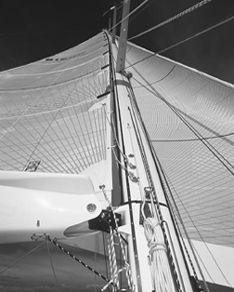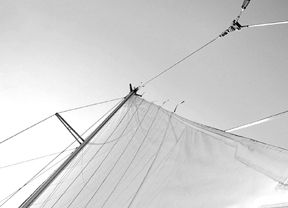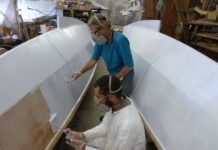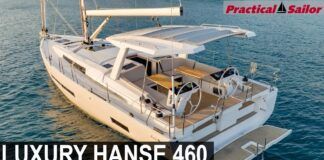For this second article, we asked all our interview subjects to price out a suit of sails (mainsail and 150-percent furling headsail) for our hypothetical No-Name 35, a 10-year-old, 14,000-pound, single-spreader sloop, which we keep in New England in the summer and take to Florida in the winter. We rarely race the boat, go offshore about four times a year, and often sail in the evenings with the family. We told them that sailshape and performance were important.

We were aware that we were throwing the sailmakers a bit of a curveball with this request. Not all of the requirements dovetailed with the others. Nevertheless, we were interested to see what would happen. This is what each had to say.
North Sails
Dan Neri wasn’t convinced our scenario represented a realistic customer and addressed his response in this fashion: “The customer doesn’t sound like a real boat owner, or if he is one, he needs some help figuring out what he wants to do with the boat. If I got this inquiry, I would call the guy and work him through to a more honest assessment of what he needs before offering a price or recommending any products.
“First, nobody cruises from New England to Florida. A 35-foot boat like this would maybe go to Maine once a summer, or to the Elizabeth Islands or Block Island a few times, and it would not use its racing sail for those trips. So it is unrealistic to say you are buying a sail for some racing and mostly cruising. Also, you wouldn’t want a 150% genoa for offshore trips. A cruising sail, or any sail designed for offshore use, should have a relatively high clew. A higher clew allows you to vary the sheet tension without moving the lead. With a low-clewed 150% designed for racing, the lead has to be moved forward and outboard as soon as you ease the sheet, which isn’t practical on a cruising boat. Also, you can’t see anything under it and water can’t get off the foredeck, so the sail is stressed (and stretched) along the foot when the bow drops into waves. When you raise the clew the overlap with the mainsail increases. So you would want to raise the clew and then shorten the LP [See the box on page 7 for explanation] to keep the overlap the same. And if you’re really going offshore with this as the primary headsail, you’d want to shorten the LP some more to get a greater upper wind range. In an ocean cruising environment I’ve found that you’re either happily motorsailing and enjoying the flat conditions, or you are depowering to keep the boat flat. Those glorious 12- to 14-knot days only happen in magazine stories.
“If the headsail is to be a roller-furling sail, the higher clew is again better because it allows the sail to roll up without the foot piling up and it allows you to roller reef the sail and still have the sheet lead to the jib track car. I usually help the customer figure out how much overlap he wants between the mainsail and headsail as step 1. Then we make the clew height so the sail sheets to the back of the genoa track fully unrolled. That gives you the greatest range for roller reefing before the sheet lead runs off the front of the track. Also, if you want to use the sail wing-and-wing for downwind sailing, it should have an LP of about 125-130 percent, based on a J-length pole. You can roller reef a larger sail to work on the pole, but in that case you lose luff length and quality of sail shape.
“If it were my boat, I would buy a fully battened Marathon mainsail with two reefs and five battens and an Antal luff track system. I would add a very simple lazy jack system made out of 3-mm Spectron 12 cord—no blocks or cleats, just the cord permanently tied in place in a fixed location, left up for racing and cruising. And I would add a roller-furling Marathon genoa, about 135 to 140 percent LP, with about a three-foot clew height.
“To make this a more racing-oriented sailplan, the mainsail would be built with two full battens and two shorter, lower battens. It would not be as easy to reef and the sailshape would degrade sooner, but the sail would be a little more adjustable and easier to trim when hard on the wind. The headsail could be made larger on the LP and lower-clewed for better race performance. In that case, you would also want a small racing jib for conditions over about 15 knots.
“Depending on the boat, you could consider a more radical change and try to set the boat up with a larger roached mainsail and a non-overlapping primary jib. That setup has plenty of advantages for easy sail handling, but suffers in the lighter winds.”
Neri supplied quotes for a mainsail of 8-oz. Dacron with two full-length battens and two reefs: $2,105. For the headsail he specified a 140% genoa of 7-oz. Dacron, with UV leech and foot, and a rope-luff reefing pad with reefing patches: $2,852.
Neil Pryde Sails
Tim Yourieff recommended his company’s Cruise Plus range of sails. “This construction standard is specifically designed for sails that will see blue-water offshore sailing, which you will encounter between New England and Florida. For the mainsail, I would recommend a full-batten sail, as this tends to greatly reduce sail flogging and therefore increases the sail’s lifespan. For offshore sailing I would recommend three rows of reefs, or two rows and a storm trysail.
“You should definitely cover the sail while it’s not in use, especially in Florida. You may wish to consider our Lazy Bag cover for this.
“For the genoa, In addition to an Acrylic UV suncover, I would strongly suggest fitting the sail with our Multi-Track foam luff system. This option helps to reduce sail draft when the sail is partially furled in order to maintain a reasonable shape when reefed in strong winds.”
Mainsail (Cruise Plus; standard roach—317 sq. ft.) Fabric—8.3-oz. Challenge High Modulus Dacron: $1,951.48. One reef: $146.35. Full battens (four): $194.97. Lazy Bag sail cover (stock color) $611.68. Total mainsail cost: $2,904.
Storm Trysail (67.55 sq. ft.) Fabric—9.0-oz. ounce, orange. Total cost: $685.
Headsail (Cruise Plus, LP 150%, with two- ply head and clew, 545.69 sq. ft.) Fabric—6.9 ounce Contender: $2,622.16. UV Suncover (stock color): $298.02. Multi-Track Foam Luff $195.58. Total headsail cost: $3,115.
Hood Sails
Tim Woodhouse and Joe Cooper offered a detailed quote that began with two fabric options for a mainsail: either 7.5-oz. Hood woven Dacron or 6.0-oz. Hood woven Vektron. Woodhouse says: “I would recommend the Vektron for the mainsail for performance, durability, and ease of handling, as well as a so-called softer hand. This is a term textile guys use to describe the softness/firmness of a material.”
Mainsail (includes a club race roach at 303 sq.ft.) Option 1: 7.5-oz. Hood woven Dacron. The sail incorporates four standard E-glass and epoxy RBS battens; batten pockets fabricated in a separate step and completely closed to separate the batten from the body of the sail; two rows of five-step stitching; slug slides or boltrope on the luff and foot as desired; leech line operable at the clew and each reef point; Hood patented press ring in the clew; standard aluminum headboard, telltales, four sail ties, and a bag. Price: $2,337. Other choices for racing and coastal sailing include two reefs, cunningham eye, foot shelf, sail numbers, draft stripes, and insignia for $633.
Option 2: 6.0-oz. woven Vektron (all else the same). Price: $2,420.

Woodhouse and Cooper say full battens are indeed an option, but they didn’t deem them necessary. The additional cost would be $470. “If the spar has an internal round slug track section, this does not lend itself easily to low-friction operation with the additional compression generated by full battens. You may also then have to look at proprietary batten receptacles and so on, so the price goes up—but we’re not convinced the value goes up with it.”
Headsail “We’re of the opinion that the 150% is too big for this boat and its stated use. We would really recommend the customer consider a sail closer to the 135% size. We also wouldn’t recommend a roller-furling genoa for the stated purpose. It is too light, and though all sorts of characters have sailed all over the place with only one headsail on a furler, we consider that practice extremely poor seamanship. So we’d specify a 135% roller-reefing headsail (484 sq. ft.) designed slightly flatter for greater utility as the sole headsail.”
Fabric: either 8.0-oz. Hood woven Dacron or 6.0-oz. Hood woven Vektron. The sail would have a luff tape, telltales, UV sunshield, foam luff pad, reinforcing at the head and tack to accommodate reefing strains, reef memory marks on the foot, leech, and foot lines, Spectra webbing in head and tack, Hood press ring in the clew, and a bag.
Total headsail cost: for Hood woven Dacron, $3,523. For Hood woven Vektron, $4,104.
Cooper and Woodhouse say that while the price of the Vektron sail might appear high, if one compares this sail to a laminated sail of equivalent service and performance, with a high-modulus fiber as the load-bearing fiber, the Vektron sail will be less expensive and more durable.
Halsey Lidgard
Paul van Dyke had several suggestions, including a novel approach to the headsail issue. For a mainsail, he recommended using 8.3-oz.,high-aspect Dacron (“This material is maintenance- free and bulletproof.”) with two reefs, one at 12% percent and the second at 30%. “The second is deeper than usual so the boat will handle well in a gale with the deep reef and a storm jib. Four full battens will dampen flogging and extend the life of the sail.” Price: $2,696.
For a genoa to be used in the lighter winds of summer as well as the occasional race, van Dyke recommended a 150% polyester laminate with a furling cover. “This sail will be lighter weight and higher performance than crosscut Dacron.” Price $3,475.
He also offered this observation: “The boat has quite a large J dimension, so it is difficult to get one headsail to do everything. With that in mind, here’s a further headsail option: An 8.30-oz, crosscut Dacron sail at 125%, with roller-reefing patches and a rope luff. This sail has very little low-end range and probably does not start working well until 12 to 14 knots of true wind. But if you did not want to change headsails on long offshore passages it would be an effective sail. Plus, it can roll down to an 85% in sail area. Price: $2,507.
“Another sail to consider, especially for offshore work, is an upwind staysail set on an inner forestay. This sail is easy to handle because it remains hanked on the stay. It works quite well as a double-head rig configuration for reaching, and can be used alone as a storm jib. We would use 7.3-oz. Dacron. You’ll have to install the the inner forestay. Price: $860.
Doyle Sails
Mark Ploch suggested two options for mainsails and headsails. He says the Dacron/Mylar combination mainsail would be great for the more modest budget. The D4 option is “Doyle’s best product, and gives you the best balance of performance and durability.”
Regarding headsails, Ploch offered both the QuickSilver II genoa and a roller-furling sail. He also offered this important caution: “We feel that something in the neighborhood of a 135% headsail is a better sail for the cruiser than a 150%. Most of the time they’re not sailing with a crew stacked on the rail and they’re usually less concerned about boatspeed when there’s under six knots of true wind than they are about heel in 15-plus knots.”
Ploch’s quote includes a foam luff on the headsail, but he says that he tries to talk most of his southern customers out of this option for two reasons. “The foam luff does indeed help flatten the sail as it rolls in, but you will always have a sail that is compromised. When the sail is rolled up it is sitting behind that fat roll, and when it is totally unrolled, the foam luff makes a thick leading edge, which is hard to read. And, in the warmer southern climates, mildew is an issue within the foam.”
Mainsail (both options moderate girth—329 sq. ft.) Option 1: Fabric 7.62-oz. Dacron with four standard battens, two reefs,shape stripe, slides, headboard, and bag. Price: $3,122. Option 2: Fabric D4 Vectran 10 with standard film/taffeta, including four standard battens, two reefs, numbers, headboard, sail slides, cunnigham, and bag. Price: $4,210.
Headsail: QuickSilver II (150%—497 sq. ft.). Fabric is 6-oz. Mylar, and sail includes UV cover and bag. Price: $3,693.Rollerfurling (150%—497 sq. ft.). Fabric is D4 Vectran with standard film/taffeta, sail includes spreader patch, UV cover, and bag. Price: $4,779.
UK Sailmakers
For a mainsail, Adam Loory recommends “a full-batten sail made of Dacron. The full battens add durability by preventing flogging, and they reduce noise during hoisting, dousing, and reefing.” He also cautioned that full-length battens are a little difficult to race with because they lock in one shape that most adjustments can’t vary. “It is also more difficult to tell when a full-batten main is luffing.”
Determining the size of the genoa, says Loory, is contingent on where the boat will spend the majority of its sailing time. “In traditionally light-air areas like Long Island Sound and the Chesapeake Bay, you want the biggest sail possible without taking a rating penalty (155% of LP is best). If the boat sails mostly in Buzzard’s Bay or San Francisco Bay, a smaller sail would be appropriate (125-135% percent of LP).”
Regardless of its size, Loory based his quote on a roller-furling sail (in this case 140% LP) and offered quotes for both a Spectra laminate and a Pentex laminate, each reinforced with the patented Tape-Drive construction system. “The biggest difference the customer will notice is that the Spectra laminate is white, while the Pentex laminate will have a gray-green color because of the UV protection in the laminate. The Spectra Tape-Drive sail will last up to eight years with proper care, while the Pentex laminate sail will last half that time.”
Loory said he wouldn’t consider quoting on a Dacron headsail, because the boat would at least occasionally be raced.

Loory also said that due to the stated purpose of the boat, the inventory really needs an additional sail, one he says that is often overlooked. “Any boat going offshore needs a working jib to use in heavy weather. A rollerfurling genoa can handle most sailing conditions and points of sail during coastal sailing, but if you’re offshore and need to go to windward for long distances in a breeze, a rolled-up genoa is not going to cut it. The aerodynamic shape of a rolled up sail is too inefficient. Coastal sailors can deal with the inefficiency since a quiet harbor is usually no more than a few hours away—an extra hour bashing to windward because of poor sailshape is inconvenient, but survivable. If you’re well offshore with the wrong jib it can lead to life-threatening circumstances.”
Mainsail (7.0-oz Dacron, full battens, two reefs, number, draft stripes, sail bag). Price: $3,061.
Headsail: Option 1—Tape-Drive Spectra Passagemaker II Genoa, including foam Luff, UV leech and foot covers, reefing reinforcements, racing numbers, draft stripes, and sail bag. Price: $4,895. Option 2— Tape-Drive Pentex Passagemaker II Genoa, including foam Luff, UV leech and foot covers, reefing reinforcements, racing numbers, draft stripes, and sail bag. Price: $4,420.
Working Jib: 8.3-oz. High Modulus Dacron jib with 95% LP, includes UV leech and foot covers, draft stripes, and sail bag. Price: $2,841.
Quantum Sails
Dave Flynn offered two possible constructions for mainsail and headsail—woven polyester, or polyester composite using oriented construction. “Your ultimate choice would be based on the emphasis of sailshape versus budget. I would probably steer you toward a woven polyester mainsail, but a polyester composite headsail,” he explained. “I would also recommend that you think hard about making the headsail smaller than a 150%, particularly if this is to be the all-purpose roller-furling sail for offshore use.” (The quote below is nonetheless based on a 150-percent LP headsail.)
Flynn also mentioned that Quantum’s website allows you to look at pricing, and “play around with different-size sails, different materials, batten configurations, numbers of reefs, etc. Education on the critical issues —like whether you should use woven or composite construction—is also available online.”
Mainsail: Option 1—(317.28 sq. ft.) 7.62-oz. Challenge HA woven polyester, including luff and foot hardware, poltruded fiberglass battens, leech cord with cleat, telltales, sail ties, and sail bag. Base Sail Cost: $2,203. Options: Reefs (2); $132; Tapered battens; $47.Total Mainsail cost: Price: $2,382. Option 2—(317 sq. ft.) Tri-radial construction with Dimension’s CX7T, including hand-sewn luff and foot hardware, poltruded battens, leech cord with cleat, telltales, sail ties, and sail bag. Base Sail Cost: $2,748. Options: Reefs (2); $164; Tapered battens; $47. Price: $2,960.
Headsail: Option 1—RF genoa (450.64 sq. ft.). using 6.62-oz. Challenge HA woven polyester, including luff attachment hardware, leech cord with cleat, telltales, and sail bag. Base Sail Cost: $1,786. Options: UV acrylic cover; $377. Foam luff; $197. Price: $2,360. Option 2—RF genoa (450.64 sq. ft.). Tri-radial construction using Dimension’s CX6T, including luff attachment hardware, leech cord and cleat, telltales, and sail bag. Base Sail Cost: $2,866. Options: UV acrylic cover; $377.Foam luff; $197. Price: $3,439.
Conclusions
New sails are a huge expense, but they’re also a big part of the game—unless you’re basically using your boat as a motorsailer (which we see more and more often on days with good breezes). You don’t have to be a racer to care strongly about the shape and set of your sails. Remember what one sailmaker said last month: Using old, blown-out sails is like driving on bald tires. They might get the basic job done, but at the cost of efficiency, enjoyment, and even safety.
The key to satisfaction is customer service, as all the sailmakers acknowledged last month. But there’s a disconnect here, we think, as far as cruising sailors are concerned. While big-boat racers have long been used to taking their sailmaker for a ride with a new sail (sometimes several rides, until it’s made right), cruising sailors, maybe because they’re ordering sails from afar, or buying “stock,” or simply don’t know when a sail is cut right or not, just don’t expect that kind of treatment. But they should. We met a cruising man this summer who was worried about where to put leads for his new working jib, but didn’t want to “bother” his sailmaker. This is silly—sailmakers expect you to bother them. It’s their lot in life. In our view, it’s more important for a sailmaker to be willing to work with you and make sure your sails are a good fit, and re-cut them if necessary, than to make them for a low price.
Customer service varies from loft to loft, not only among small outfits, but among the big sailmaker groups, and from boat style to boat style. The owner of a Cal 2-29 said in our survey, “I have found small, independent sailmakers to be a little less high-tech, but very capable and customer focused.” We don’t disagree, but we also know that local representatives of the big chains are sometimes more expert and efficient at making certain sails for certain boats. So there are two questions to ask of any prospective sailmaker: 1. Have you made sails for my kind of boat before? 2. Will you go out with me?
Also With This Article
Click here to view “Sailplan Measurements.”
Click here to view “Sails & Sailmakers: Reader Survey Results.”


































